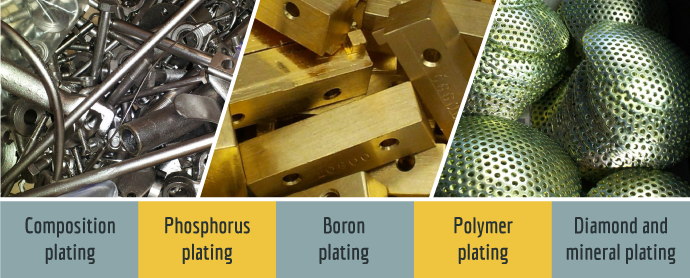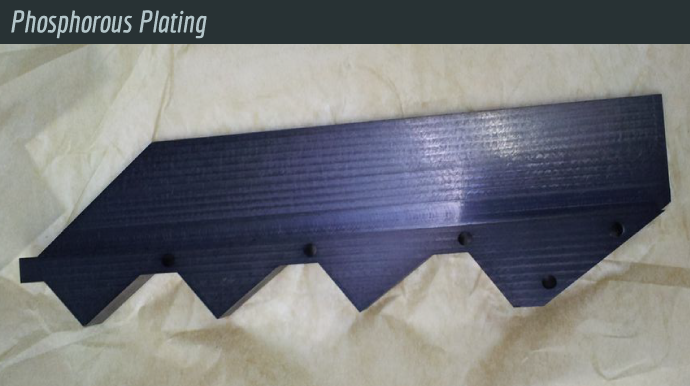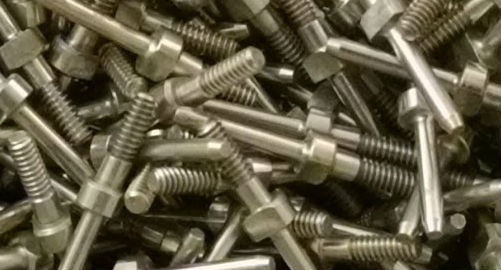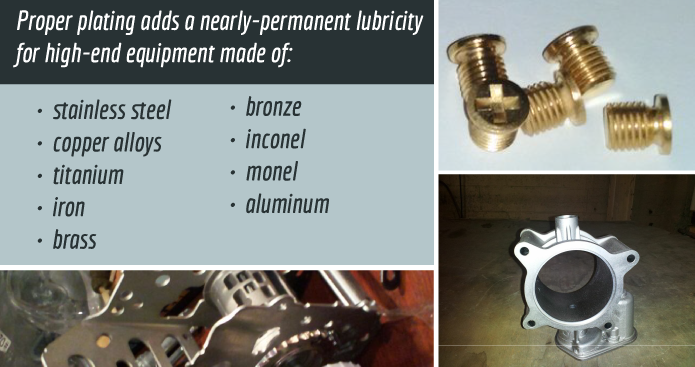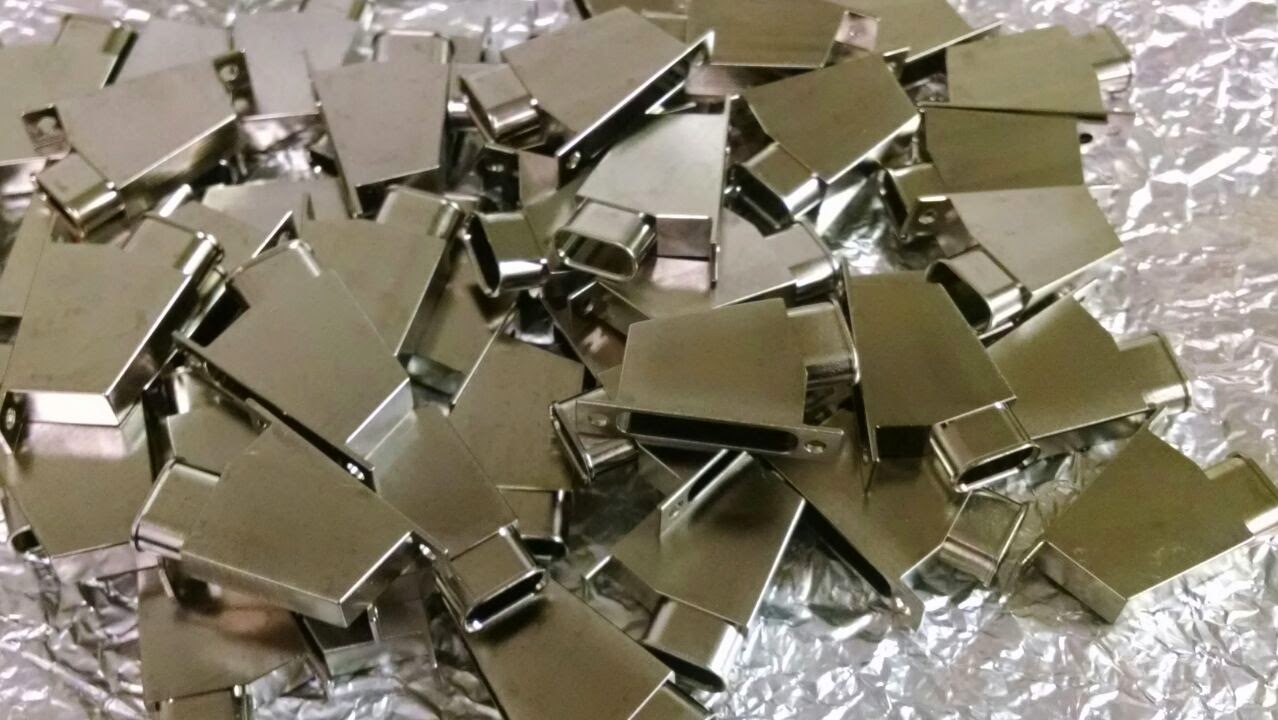Electroless nickel plating can help you keep your industrial machinery running like new for a lot longer, even in harsh environments with acidic conditions, lots of wear-and-tear, or areas where you need to minimize friction because lubrication is difficult or too costly.
The best part of electroless nickel plating is that it can be done professionally in large batches, making the whole process more cost-effective and generating significant long-term savings.
It’s the kind of thing you want to bring to your boss.
While electroless plating is relatively new to some industries, it has a proven track record of adding a variety of support and service. You can specialize your protection through the right use of the right baths that contain a variety of metals and elemental dissolved salts to help plate your metal.
The new chemical reaction creates a top binding so you’ll never have to worry about flaking. Your benefits come from the different processes available on the market today, including:
Sharretts Plating Company has provided quality electroless nickel plating solutions for over 80 years and their helpful technicians can provide you with a better understanding of where to take your plating needs.
Plating vs. Coating
Coating is simply a liquid or solid covering of a uniform, single-element layer to a metal or other surface via compression and glue. Essentially, this is gold leafing or gilding and it’s been a practice around since at least 2300 B.C.
Initially, sheets of thin precious metals like gold and silver were beat onto the surface of another metal. Sometimes glue or another adhesive was applied before the gold was hammered, allowing it to stick better. Some artists would use specific applications of heat to gold in certain areas where it would cause better adhesion between the glue and underlying metal.
Some coatings are also created by dipping an object into a liquid bath of pure precious metal and allowing the bath to cool enough so that objects with a natural affinity will take on properties or amounts of the liquefied precious metal.
Electroless nickel coating and plating add a whole new set of elements to the process.
Electroless nickel plating uses a chemical reaction where a reducing agent reacts with a metal, allowing nickel and other elements in a liquid to deposit as a layer on top of the base metal or plastic. Many people have heard of electroplating, which performs a similar act, but this electroless nickel plating does not require an electric current for the process to take place.
Electroless plating offers benefits over both coatings and electroplating because it can work regardless of an object’s shape and density while providing a higher-grade coating that will work on a variety of non-conductive and non-porous surfaces.
Phosphorus Plating
Many coatings will contain high phosphorus content for added high-corrosion or moderate wear resistance. Using a phosphorous electroless nickel plating process will provide a tradeoff, however, as a variety of different phosphorus levels produce differing results based on the material and the type of environment that the plated item is exposed to.
These electroless nickel plating solutions offer you a wide range of protection, but you’ll want to discuss the best fit for your needs with qualified electroless nickel platers.
Phosphorus baths that provide an added benefit without introducing too much fragility or losing the nickel plating benefit come in a range of 5% to 13% phosphor. The available phosphorous electroless nickel baths use a different percentage to provide a specific benefit:
High-Phosphorous Electroless Nickel: These baths contain between 10% and 13% phosphor and are typically used in very corrosive environments. This type of bath forms a glass-like coating that rests on the material’s surface. These amorphous surface layers are free of crystalline structure, so there’s little risk of the development of a weak area where corrosion or wear may break through. Unlike some other baths we will discuss, this nickel plating is non-magnetic when plated, making it a top choice for electronics and other parts or machinery that need a layer of shielding. The coating can also serve as a barrier to interference cased from other electronics in the vicinity, though specific signal blocking and allowance patterns should be discussed with a trained plating professional.
Mid-Phosphorous Electroless Nickel: A mid-phosphorous electroless nickel coating provides a good balance between corrosion and wear protection. These baths usually contain between 5% and 9% phosphor and will provide a bright sheen to the object being coated. These are usually among the most price-competitive solutions and are a strong candidate for improving tolerance of moving and under-sized parts. Unfortunately, when used on some metals, such as steel, this coating creates tensile stress (tension) when it is deposited and this can lead to minor quality loss on very-precise parts.
Low-Phosphorous Electroless Nickel: When it comes to phosphor-nickel plating, baths with up to 5% phosphor offer a wide range of benefits and protections. These baths allow materials to survive higher-temperature environments, increase resistance to general wear, increase conductivity and reduce the level of solderability. Unlike the other phosphor baths, this type adds little corrosion protection in acidic environments (though it does offer stronger base-environment protection). It also generates compressive stress on metals, potentially the worst for steel, which receives a much-reduced fatigue failure.
These different levels of a nickel-phosphorus alloy can generate the right type of corrosion protection for your job, as well as help you with secondary tasks such as parts identification – a benefit of most electroless nickel plating options.
Boron-Based Electroless Nickel Coatings
For environments with little need for corrosion protection, a boron-based nickel bath can be the right fit. These baths create a top-notch electroless nickel coating common in high-tech applications for the automotive, aeronautical and aerospace industries.
Boron electroless nickel platers come in two bath types, with a low-boron setting containing between 0.5% and 3% boron, while the high-boron bath will have 3% to 5% of its contents made up by boron.
The low-boron bath provides an improved solderability for materials as well as increases their conductivity without risking material damage. This makes its primary use in the electronics sector on both large and small parts. The coating is highly-porous compared to other coatings and, as such, will cause concern in corrosive settings or settings where a large amount of fine-material deposits may be made on the surface of the plating.
The high-boron baths can add a significant hardiness to the material in question, plus support heat treating for a significant increase in further resilience. Even prior to the heat treatment, this coating can take on the same strength as chrome, making it a smart and economical replacement for chrome plating for the auto, air and space industries. Unfortunately, it suffers from the same prevalence of porosity, and high-boron nickel plated items will not stand up in highly-corrosive environments or industrial settings.
Boron electroless nickel platers and alloys can also be combined with metals such as cobalt, tungsten, rhenium and iron to form other alloys that offer a variety of different protection portfolios.
Ceramics and Mineral Electroless Nickel Platers
Sometimes diamonds can be a man’s best friend, especially in the electroless nickel plating process.
Nickel electroless plating can use diamonds and other carbon structures in its bath makeup to create composite coating that adds extreme protection from wear and corrosion.
Now, these aren’t your normal diamonds, so they’re not going to cut up machinery or add the slice-and-dice quality that diamond drills employ. Diamond plating tends to use shock-synthesized polycrystalline diamonds that are somewhat rounded. Diamonds naturally form in crystalline structures with few stress seams and, when broke along these points, create incredibly sharp edges. Polycrystalline diamonds have millions of such points, making the edges infinitely small and relatively smooth.
Using this in a coating mixture reduces the abrasion and wear loss of the coating, even at standard levels of under 1 mil.
This type of coating typically has a variety of post-coating work because the process leaves the material coated with a rough, dull set of layers that may obfuscate the part. Most services will provide plate grinding and buffing to improve the overall aesthetic.
Diamonds are the big headline grabbers but there are a variety of other mineral and ceramic coatings that provide similar benefits. These will give a mix of wear and corrosion protection to nickel plated materials with many different price points along the way. To get a handle on which is best for you, it’s best to talk to a plating professional about your specific protection needs.
Top alternatives to diamonds include:
- aluminum oxide
- cassiterate
- columbite-tantalite
- polyvinyl chloride
- silicon carbide
- tungsten carbide
Different combinations and types are offered by different electroless nickel platers, but you’ll have a wide range of options to choose from whenever you pick a qualified partner. Like other decisions where you have many options, it’s best to discuss all of the electroless nickel plating solutions that could fit your needs.
Playing With Polymer Plating
Flurocarbons and other polymers can be part of the electroless nickel coating process when you need to minimize friction and reduce damage to a part through use. This is among the most versatile of the electroless nickel coating subsets because of the wide range of materials that can be used.
Depending on the mixture, you can use between a 10% and 30% polymer mixture with the remaining as the standard nickel plating. In these cases, it’s common to use a fluoropolymer, which is a fluorocarbon-based polymer that has very strong bonds and can offer a high resistance to acids, bases and solvents.
All in all, polymer electroless nickel platers offer a wide range of benefits from the previously mentioned to:
- corrosion resistance
- dielectric properties
- hydrophobic and hydrophilic surfaces
- increased conductivity
- non-stick
- non-wetting
- static dissipation
- whine/squeak reduction
In these plating cases, a nickel layer is established with a graded interface added on top. The polymer is then plated on top of this graded interface, improving the ability for the coating to bond to the metal and resilience of the coating.
One of the most popular name brands for this type of coating is Teflon. Teflon and similar polymer plating options can create strong release and anti-galling coatings.
A nice thing about polymer coatings is that they can be tailored to your specific industry. While Telfon may have a relatively low melting point, 330° C (626° F), you can also use polymer blends that will have melting points as high as 1000° C (1832° F).
While there have been previous environmental concerns with some polymer-based coatings and plating, research has produced a number of alternative processes that are proving to be better for the planet as well as for the materials being coated.
Some of these newer processes include the use of plasma activation, laser radiation and ion beam radiation in order to change the surface properties of the polymer and metal, which can help in the electroless metal plating process.
Improvements have pushed down requirements to just a layer of 0.001 inch to 0.0025 inch per surface. This has allowed more processes and polymers to be used in a safe measure with FDA, USDA and NSF requirements for a wide range of consumer-facing uses, such as packaging and protection in the beverage, food, pharmaceutical, computer and medical industries.
Composite: The Electroless Nickel Plating Process Catch-All
Another option for an electroless nickel plating or coating is when you add another set of particles in small sizes and quantities to the bath, creating a composite material. You can use a combination of hard and soft particles in the nickel coating mix and generate a uniform coating that has a specific benefit based on materials, hard or soft particle volume, and even the final method of application.
These nickel plated items can be managed in a wide range of ways to provide a multitude of benefits.
Composites have been growing in popularity because of their savings both on cost and on environmental factors.
Some of the big benefits found by almost all composite coatings include:
- the use of less nickel and thus a thinner thickness is required
- coatings wear as well as, if not better, than conventional coatings even at reduced sizes
- composite coatings last longer
- increased bath-life for the company doing the plating, which can generate overall reduced costs for customers
- longer life of parts
- nickel metal can be reclaimed easier in recycling
- less metal is released into the environment in the event of a breakdown
One of the most common composite coatings makes use of the Polytetrafluoroethylene (PTFE) polymer (DuPont’s Teflon is the best known variant of PTFE). Most PTFE composite blends are specifically made concoctions to provide a specific application benefit. PTFE itself is low-friction in its application and adds a hardiness and hardness to electroless nickel. The blend can also add a lubrication element, wear resistance and corrosion resistance.
Some of the more common deployments of PTFE are for industrial applications in machinery and equipment such as:
- air cylinders
- bearings
- heating elements
- injection-mold machinery
- pump motors and rotors
- spray nozzles
- valves
Because of its varied support, polymer coatings can often fit your specific needs.
Why Select an Electroless Nickel Plating?
Industrial machinery and components are the biggest beneficiaries of electroless nickel plating and coating because it can protect them against the intense environments and punishment they take on a daily basis.
The advent of electroless plating has given engineers and mechanics the ability to plate a wider range of non-conductive surfaces, expanding the types of materials that can be plated. The ability to plate without electricity also means you’re not forced to coat in stages with non-covered materials that could eventually serve as an Achilles’ heel for your equipment.
The electroless nickel coating produced is also less porous than electroplated nickel or plated chrome, so you’re getting a better barrier between your equipment and the elements; this is especially true when it comes to corrosion protection or applying a protection that can’t produce much compressive stress.
For your industrial needs, electroless nickel plating can be the right fit for making sure your machinery has a long life and performs consistently with a reduced maintenance schedule. Nickel plating may be just the thing that saves your company lots of time and hassle when you get it done from the right shop at the right price.


